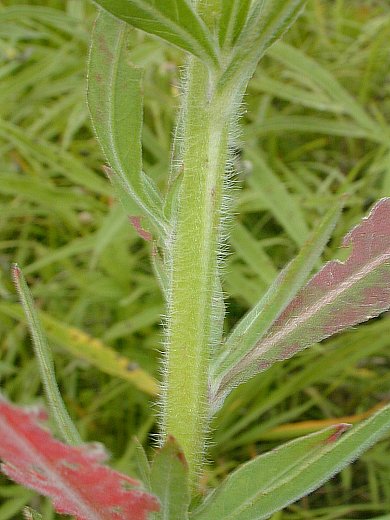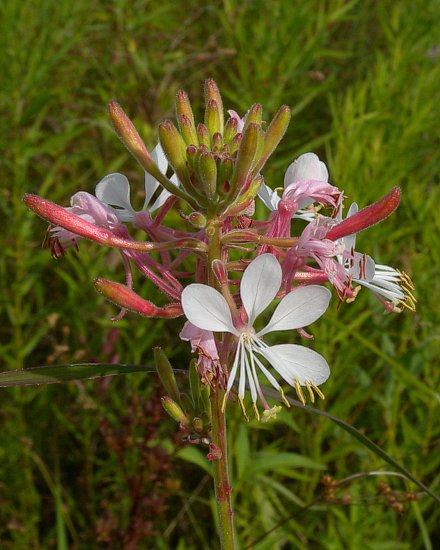Description: During the first year, this plant develops a rosette of basal leaves. During the second year, this biennial plant bolts to become 3-7' tall at maturity, branching above. The stems are light green, angular or terete, and moderately to densely covered with spreading white hairs. Alternate leaves occur along these stems that have ascending blades; they are sessile or short-petiolate. The leaf blades are up to 7" long and 1" across, although they are usually about one-half of the maximum size. The leaves are narrowly lanceolate or elliptic in shape, while their margins are entire (toothless) or slightly dentate. The leaf surfaces are yellowish green or medium green and glabrous to slightly pubescent (usually becoming more glabrous with age). However, during the autumn, the leaves often become reddish in response to cold weather. The upper stems terminate in open panicles of floral spikes that are up to 2½' long and across. In each spike, the sessile flowers bloom gradually from the bottom to the top with flower buds above and developing seed capsules below.

Each flower is about ½" long
and across, consisting of 4 white to pink petals, a narrow calyx tube
with 4 green to red sepals at its apex, 8 long-exserted stamens, and an
inferior ovary with a long-exserted style. The petals are oblanceolate
in shape, tapering to narrow clawed bases; they are arranged in a
semi-circle above the reproductive organs. The sepals are
linear-lanceolate, short-pubescent, and strongly recurved or deflexed
(bent downward or away from the petals). The stamens have white
filaments and slender yellow anthers. The slender style is white; it
has a 4-lobed stigma at its apex. The branches of the
inflorescence are light green or reddish green, angular or terete, and
short-pubescent. The blooming period occurs from mid-summer to
mid-autumn, lasting about 1-2 months. The flowers are replaced by seed
capsules that are 6-8 mm. long, fusiform (spindle-shaped), slightly
4-ribbed,
and short-pubescent. Each capsule contains a few seeds.
Cultivation:
This biennial plant prefers full sunlight and more or less mesic
conditions. It
tolerates many kinds of soil, include those that contain loam, clay,
gravel, or sand.

Range
& Habitat:
The native Biennial Gaura occurs in most counties of Illinois, where it
is occasional to locally common (see Distribution
Map).
Habitats include mesic prairies, meadows in wooded areas, limestone
glades, abandoned fields, gravelly banks along rivers, roadside
embankments, areas along railroads, and waste areas. Biennial Gaura
prefers disturbed areas where there is reduced competition from other
plants, although it is occasionally found in higher quality habitats.
Faunal Associations:
The flowers are cross-pollinated by long-tongued bees (especially
bumblebees) and nectar-seeking moths, including the Northern Corn
Earworm Moth (Heliothis
zea). Other insects feed destructively on the
foliage, flowers, developing seed capsules, and plant sap of Biennial
Gaura. Insects in this latter group include aphids (Macrosiphum gaurae,
Macrosiphum pseudorosae),
leaf-mining larvae of a Momphid moth (Mompha
argentimaculella), gall-forming larvae of a a Momphid moth
(Mompha
rufocristatella), and larvae of the Primrose Moth (Schinia florida)
and
Gaura Moth (Schinia gaura).
Larvae of the latter two moths feed on
the flowers and developing seed capsules. The adults of these two moths
often hide near the flowers of Biennial Gaura during the day; they are
well-camouflaged because of their pinkish or reddish colors. This
plant's relationships with vertebrate animals is currently unavailable.

Photographic
Location:
The photographs of plants were taken along a railroad
in Champaign, Illinois, and at a prairie of Meadowbrook Park
in Urbana, Illinois.
Comments:
During late summer when this tall plant is in full bloom, its lanky
stems and flowering spikes have a tendency to sway with each passing
breeze. Biennial Gaura (Gaura
biennis)
has not received much attention because of its untidy appearance and
slightly weedy nature. However, it provides attractive flowers during
the hot and dreary month of August, when other plants are usually
dormant. Biennial Gaura closely resembles Large-flowered Gaura (Gaura
longiflora),
except this latter species has short appressed hairs along its stems,
rather than long and widely spreading hairs. Large-flowered Gaura has a
more western distribution than Biennial Gaura, and it is less common in
Illinois. Another species with a more western distribution,
Small-flowered Gaura (Gaura
parviflora), has more densely pubescent leaves, a less
branched
inflorescence, and smaller flowers than Biennial Gaura. Small-flowered
Gaura is uncommon in Illinois, where it is adventive.